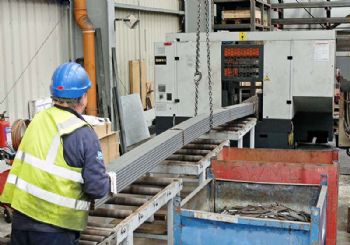
Carlisle-based steel stockholder Thomas Graham & Sons has significantly increased its cutting capacity by purchasing a new KastoWin 4.6 bandsaw from Kasto Ltd (
www.kasto.com) in Milton Keynes — specifically for a contract that involves cutting annually 350 tonnes of mild steel alloyed with boron.
The lengths of flat bar are used to produce chain links for forestry vehicles, and they need to have a high boron content to promote hardness during heat treatment.
Bundles of 24 bars with a 50 x 20mm cross-section and two bevelled edges are sawn into 280mm lengths, with each cycle producing 240 billets. These are removed from the output roller table before the next cycle starts.
Operations director Phil Barnes, who has been with Thomas Graham for 17 years (
www.thomas-graham.co.uk), said: “The KastoWin is our first bandsaw from this supplier but our 11th on-site.
"Boron steel is not especially difficult to cut using a standard bi-metal blade, but the automatic Kasto saw does it extremely well, day in and day out, easily holding the required ±1 mm tolerance.
"We were expecting each bundle cutting cycle to take 8hr; in fact, it is completed in just 3.5hr.”
Mr Barnes explained that this performance is partly down to the 10min per cycle saved by the Kasto saw’s ability to start the trim cut automatically when each new bundle is loaded.
On other machines, it is necessary to first cut the bundle to level the face, then measure the bar before production can start.
Also key to achieving the high level of productivity is the bandsaw’s adaptive down-feed, called KastoRespond.
It allows a band feed rate that is higher than would otherwise be feasible, as it is automatically backed off momentarily if the built-in pressure sensor detects an increase in the cutting force.
This can occur as the blade reaches the transitions between layers of bars in the bundle, or if it encounters a hard spot in the material.
The optimal force on the blade is therefore maintained throughout the cycle, ensuring a good quality of cut and avoiding damage to the blade.